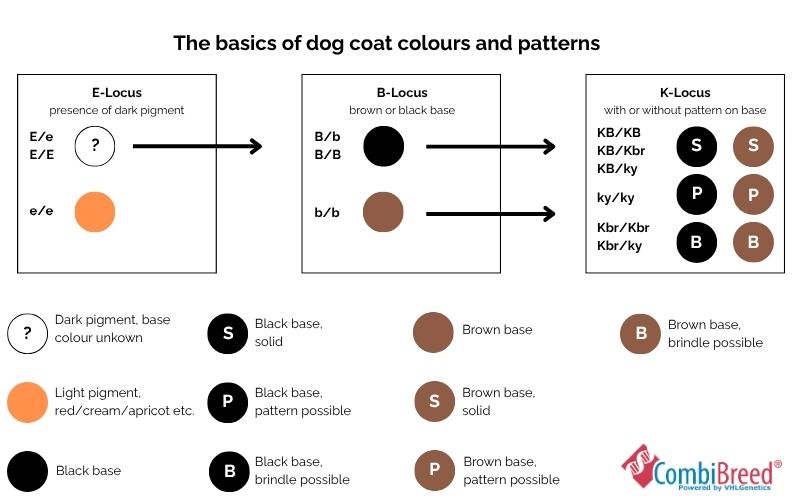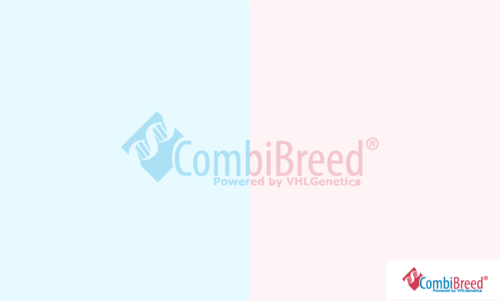B-Locus Dog (Brown)
Coat colour in dogs is regulated by a complex interplay of various genes, often known as ‘loci.’ The Brown locus, or B-Locus, is associated with the tyrosinase-related protein 1 gene (TYRP1), which governs the synthesis of eumelanin, the black pigment (E-locus). Multiple mutations on the B-Locus lead to the conversion (dilution) of black pigment to brown. Brown can also be called chocolate or liver, depending on the breed. Besides the B-locus, other brown variants on other loci also exist. An example is the cocoa coating in French Bulldogs, caused by a mutation in the HPS3 gene.
Dogs that are homozygous for the b allele (b/b), show a transformation in hair colour. Across different breeds, this colour variation may be categorized as brown, chocolate, or liver. Additionally, the dog’s nose and paw pads will exhibit a lighter brown instead of the typical black. Brown coat colour can only exist if black pigment (eumelanin) is present. It has no effect on pheomelanin (red/yellow) coat colours. However, sometimes the nose and paw pads of these dogs still can be brown.
Inheritance
| Genotype | Coat Colour | Description |
|---|---|---|
| B/B | No brown | Mutated b-allele not present. The basic colour is not modified. It can only pass on the wildtype allele B to its offspring. |
| B/b | No brown | Carrier of the brown variant. The basic colour is not modified. 50% of the offspring will inherit a copy of the b-allele, the other 50% will inherit the wildtype B-allele. |
| b/b | Brown (if black pigment is present) | The brown phenotype is present. The final coat colour depends on the interaction between other colour genes (loci). 100% of the offspring will get a copy of the b-locus. |
| B/b or b/b (> 2b) | Unkown | This dog carries at least two b-alleles and possibly one B-allele. The colour of this dog can be brown or black. Typically, dogs carry two copies of each locus, one from the mother and one from the father. Therefore genotypes often consists of two alleles (like B/b). Because there are six possible alleles and these mutations do not occur exactly on the same spot, it is theoretically possible that an animal has two or more variants of the B-locus. Current methodology cannot distinguish these copies and therefore give an inconclusive result. However, the final genotype can be determined by using the phenotype of these ‘B/b or b/b’ tested dogs. Dogs with a brown phenotype (may have a brown coat, and will typically have a brown nose and footpads) will have the b/b genotype. Dogs with a black genotype (black coat, nose and footpads) will have B/b.
Option 1 (B/b): The dog is a black nose, black footpads and black coat black. In this case it also carries one copy of the B-allele. Option 2 (b/b): The dog has a brown nose, brown footpads and (possibly) brown coat. In this case it carries only b-alleles. |
For some breeds, specific alleles exists. The be (Lancaster Heeler) and bh (Siberian Husky) alleles inherit in an autosomal recessive way. Therefore, in the above table, replace b by be or bh respectivly to get the matching description. For an extended explanation see additional information.
Because black pigmentation (E-locus) is such an important factor for the B-locus to express itself, an extended table has been used below to describe genotype results on both loci to show the effect on the phenotype from both loci.
| Genotype on B-Locus | Genotype on E-Locus | Interpretation |
|---|---|---|
| B/B | Em/Em, Em/E or Em/e | Black, melanistic mask is not visible |
| B/B | E/E or E/e | Black, no melanistic mask present |
| B/B | e/e | Red/Yellow/Cream, no melanistic mask present |
| B/b | Em/Em, Em/E or Em/e | Black, melanistic mask is not visible |
| B/b | E/E or E/e | Black, no melanistic mask present |
| B/b | e/e | Red/Yellow/Cream, no melanistic mask present |
| b/b | Em/Em, Em/E or Em/e | Brown, with melanistic mask |
| b/b | E/E or E/e | Brown, no melanistic mask present |
| b/b | e/e | Red/Yellow/Cream, no melanistic mask present |
For some breeds, specific alleles exists. The be (Lancaster Heeler) and bh (Siberian Husky) alleles inherit in an autosomal recessive way. Therefore, in the above table, replace b by be or bh respectively to get the matching description. For an extended explanation see additional information.
Be aware that additional loci (for example K-locus, D-locus, A-locus) could also influence the coat colour and can produce undescribed results. How B-, E- and K-locus influence eachother is demonstrated in underneath graphic
Additional information
B-locus has many alleles and some additional alleles only exist in specific breeds. Most of these alleles have the same (autosomal recessive) inheritance and effect. To simplify the results, alleles bc, bs and bd are reported as b. Other laboratories still may report the other alleles instead of a general b. Be aware of this possible difference when comparing test results from multiple laboratories.
The alleles for specific breeds are handled as individual tests and thus produce a separate result. However these alleles are also autosomal recessive and thus inherited in the same manner as the other b-alleles. In the table above, you can replace b by be (Lancaster Heller) or bh (Siberian Husky) and you will still have the right description for the effect on the coat colour. Australian Shepherds have their own variant as well, but this variant is already reported with B and b.
The expression of the final coat colour is influenced by many loci. Genotypes in other loci (like E-locus, K locus, B-locus, A-locus and D-locus) can influence the final phenotype. Furthermore, not all loci that cause brown mutations are known yet. Be aware that an individual result can deviate because of these interactions and unknown effects.
Relevant tests
- H733
- H767
- H764
- H453
- H857
